Email Marketing Tips to Improve Open Rates

About Branding – Tips You Need
May 22, 2019
Miraikan In Odaiba, Tokyo
May 24, 2019Every year, marketers face new challenges. From changes in the way marketing campaigns get delivered to new technologies that revolutionize the way we do things, there’s always something that needs adapting to and altering.
And even though email marketing is going nowhere in 2019, there are going to be some key shifts and challenges that marketers need to overcome.
Below, we explore what changes you need to watch out for before showing you how to create email campaigns designed for success in 2019.
The key to successful email campaigns in 2019
1. Make Sure You’re Implementing Segmentation
Marketers know that segmenting email marketing lists can improve open and clickthrough rates. MailChimp’s latest user data showed that segmented campaigns get 14.64% more opens and 59.99% more clicks than non-segmented campaigns.
That said, figuring out the best way to segment your email marketing lists can be a huge undertaking.
This post will show you 10 quick and easy segmentation strategies that you can get started on today.
1). Demographics
The first way many marketers begin email marketing segmentation is by demographic data. Information such as age, gender, company position, and income level can tell a lot about a person’s needs and interests.
The more information you can get about your audience in the sign-up process, the more options you’ll have for demographic segmentation. Be careful with this, though, because asking for too much information can scare people off from signing up at all.
The easiest way to segment by demographic information is with your website forms. Your email marketing platform will allow you to customize the email sign-up questions, or you can use a plugin to create opt-in boxes.
If you use a tool like Campaign Monitor, demographic segmentation is a part of the email builder. Just select the content you want to segment, and the demographic you want to show it to.
2). Survey or Quiz Results
A survey gives you the opportunity to not only get that valuable demographic information, but also insights into individual tastes, preferences, and beliefs.
If you want to send out a survey to your audience and get a lot of responses, you should probably create some kind of incentive for completing it – such as entering them in a drawing to win a prize.
Or, instead of pitching it as a survey, turn it into a quiz that offers results that would interest your audience.
There are a lot of different ways to create custom surveys for your audience. If you’re on WordPress, you can use the Quiz and Survey Master plugin to create your custom survey. It also integrates with MailChimp, so you can export your results.
If you use Aweber, you can create a free survey with Google Documents, Survey Monkey, or SurveyGizmo, and then integrate them into your Aweber emails.
3). Email Engagement
Email engagement is another very basic way to segment your lists, but it can have a huge impact on your overall results.
Open rate and clickthrough rate are the main metrics here, which you keep track of in your email marketing service.
You can segment by engagement by designating active vs inactive users, such as someone who hasn’t opened your emails in three months. You can then create a specialized campaign designed at re-engaging your inactive subscribers.
Or you can focus on subscribers who do engage, and target them more specifically. For example: you send out an email announcing an upcoming sale, and everyone who clicks through the email link can be categorized as “interested.” You can then create a special campaign to further target them as likely buyers from the sale.
If you use Mailchimp, segmenting by engagement is simple. In the “Activity” tab, you have options to see a variety of subscriber behavior:
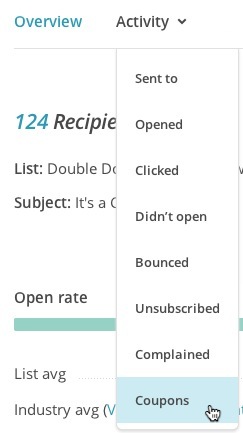
You can then create unique segments including any or all of these metrics:
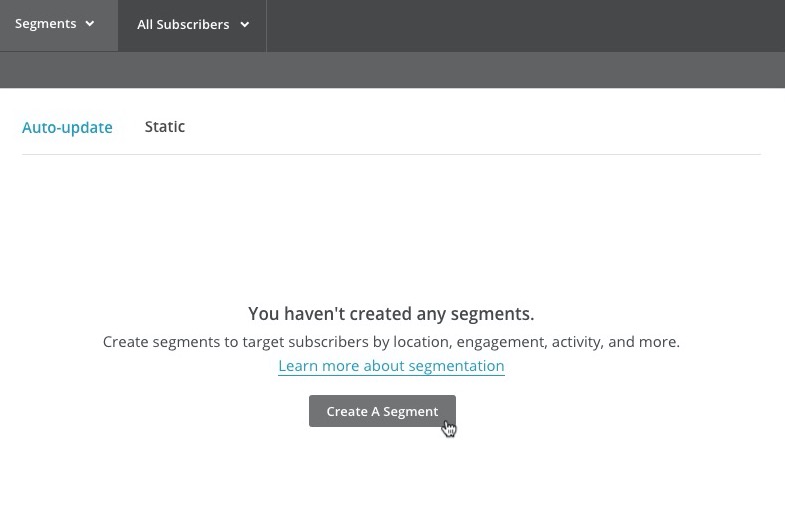
4). Geographic Area
There are a lot of different ways to use geographic location data, making segmentation by geographic area a valuable tool – especially for businesses where location greatly influences purchasing decisions.
Litmus, for example, used geolocation to send out targeted emails for their Email Design Conference in San Francisco, London, and Boston, including helpful details for each location:

Their targeted emails got them a 68% open rate, compared to a 22% open rate for the general conference announcement.
Other ways companies can use geographic data include:
- Time-based email messages. Stagger your emails to send out at optimum times for customers in different time zones.
- Advertising regional promotions. Send focused emails for events in certain store locations.
- Live webinar or AMA invitations. Adjust event timing based on audience location.
- Personalized travel directions. Customize directions to a store or event based on the reader’s geolocation.
- Where a customer shops. Send out offers specific to the physical store a buyer frequents.
- Location-specific content. Use a location in your headlines or content to draw attention and offer a personalized experience.
5). Past Purchases
Segmenting by past purchases is another simple way to optimize targeting. The easiest way is to start sending out email recommendations for similar items or accessories that would go well with their previous purchase.
Or, if a customer bought something that requires replacement, refilling, or renewal, you can send out targeted emails based on their potential needs.
To do this in MailChimp, you’ll need to use either the eCommerce360 plugin or eCommerce360 tracking for purchase activity to appear in your campaign reports.
Then you can segment by product purchased, category of product purchased, or even combined factors.
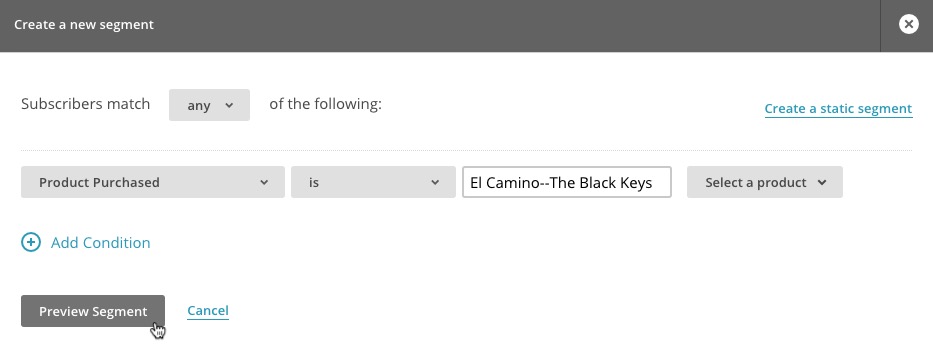
6). Amount Spent
If you sell a range of high and low dollar items, amount spent can be a great segmentation strategy. Use customer expense history to determine which customers are likely to buy more expensive items and which are more interested in affordable, low dollar items.
Then you can send out targeted emails featuring products that are actually in each person’s price range.
Intermix, a women’s clothing retailer, used this strategy to decrease the value of discounts they sent out. They segmented customers into three groups:
- VIPs – Shoppers with high disposable incomes
- Sales shoppers – People motivated by discounts
- Brand shoppers – Customers who showed loyalty to a brand, but were price-conscious
VIPs were sent out non-monetary offers (exclusive invites and events), while the other two segments were sent discount offers ranging from 10-30%.
After everything was said and done, the effort got them a 15% increase in annual revenue.
7). Position in the Sales Funnel
Segmenting by where your audience is in the sales funnel is one of the most valuable ways to customize your messaging.
Someone at the top of the funnel should be receiving different targeted emails than those at the bottom. For example, for a group of brand-new subscribers, their emails should be more generalized, giving a range of the products or features you offer – such as a series of welcome emails introducing them to the brand.
If they’ve been signed up for a while and interacted with certain email content (such as clicking through a link), you can use this information to determine what exactly they’re interested in, and send more targeted emails on that product or service.
Cart abandonment is a common indicator that someone’s at the bottom of the funnel. In 2015, the rate of cart abandonment was 68%. They had intention to buy, but something stopped them.
This presents an opportunity – you can send out a follow-up email reminding them that their cart is still available, or a message featuring the products they were about to purchase.
Here’s a nice example from Fab on how you can follow up:
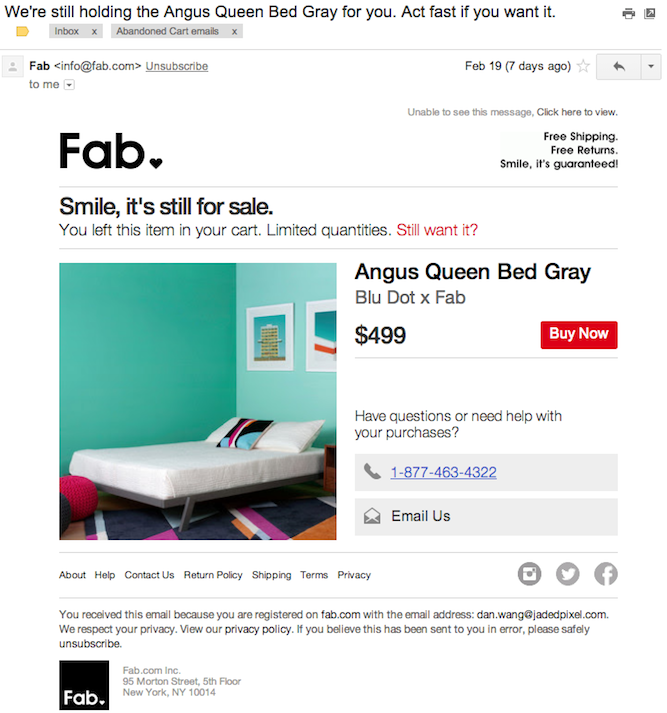
8). Website Behavior
Keeping track of website behavior is another simple way to get more information about visitors’ interests. For example, you can send targeted emails based on the specific pages they visited – but that’s far from the only option.
The sheer amount of behavioral data you can gather now is pretty impressive. There are tools, like BeamPulse, that keep track of visitor scrolling behavior, icons clicked, time active on page, menus visited, and more.
With the ‘Goals’ feature in MailChimp, you can also send out targeted emails based on website activity, such as:
- Pages people visited
- Pages they didn’t visit
- People who visited one page but missed another related page
- What videos they watched (and how long they watched them)
Set up Goal Autoresponders with Mailchimp, and you can send out automatic targeted emails based on the content people did or didn’t engage with on your website.
9). Time Since Last Purchase
Time since last purchase can be a valuable segmentation strategy, since it doesn’t make sense to lump a customer who last bought from you months ago in with one who bought something last week.
Instead, you could split them up into two major groups:
a. Frequent Buyers
This group purchases something from you at least monthly. They like your brand and are obviously interested in your products, so you target them by:
- Upselling product or plan upgrades.
- Offering promotional deals.
- Promoting new features or products.
b. One-Time Customers
This group bought one of your products six months ago but hasn’t been back since. Or maybe they used to be a frequent buyer but fell off the grid. Your emails should be targeted at drawing them back to your brand, by:
- Offering personalized discounts on former purchases.
- Highlighting the company’s positive attributes.
- Sending reminders to renew/repurchase.
Onward Reserve, an online menswear retailer, used a similar approach, segmenting by best customers (at least three purchases), non-purchasers, and churning customers. They tailored messages to each group:
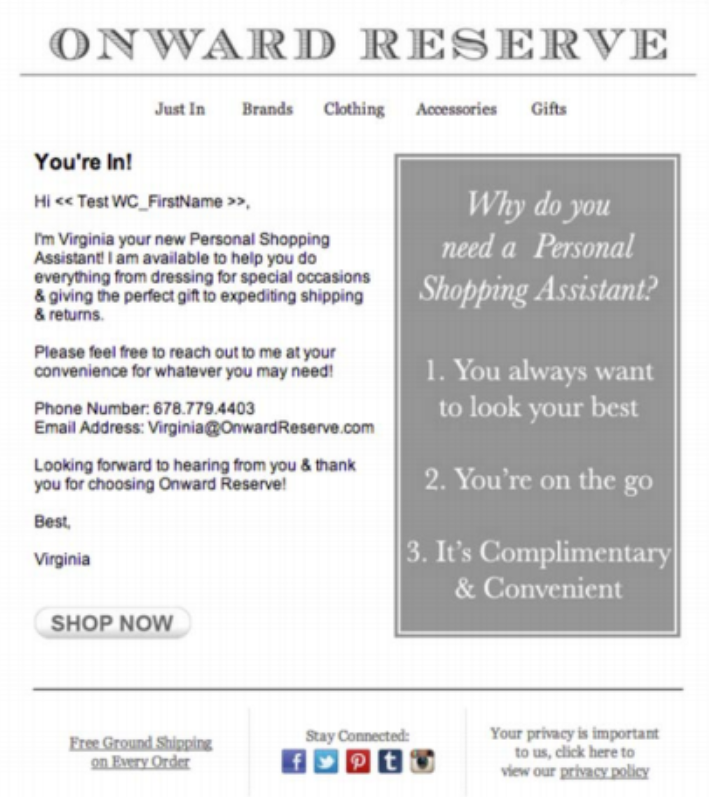
Their efforts got them:
- 278% increase in revenue
- 183% increase in CTR
- 41% increase in open rates
10). Personal Interests
This tactic is a little more advanced, but it’s still fairly simple to do with the right tools.
You can get detailed information about subscribers’ personal interests by creating user profiles on your website or using an email subscription center.
Here’s an example from Amazon:

You can ask your audience to indicate their preferences when signing up – and give them plenty of opportunities to update those preferences by including a CTA in your emails.
By asking your subscribers to indicate their preferences, you can easily cut through the noise by targeting your audience based on their real interests.
You can create custom subscriber preferences with email marketing tools like Campaign Monitor.
2. Understanding the Data
In order to offer the aforementioned personalization for your customers, it’s important to know what data you need to gather and how best to utilize it. However, with so much data available, it can be difficult to know where to start.
And you’re not alone. As Forbes recently reported, the vast majority of companies are overwhelmed by the amount of data they have access to.
Put aside those graphs and spreadsheets and start looking past this data to see what it’s actually showing you: how your customers are behaving. This data explains what your customers like, don’t like, and what actions they’re happy to perform.
It’s also important to integrate all of your data points with each other, utilizing platforms like Google Analytics alongside your email metrics. This will give you a holistic picture of what your customers want and expect from you, allowing you to spot and overcome any potential challenges you face.
3. Nurture and Engage Your Existing Audience
While growing your email list receives most of the attention when people talk about the success of email marketing strategies, it’s just as vital—if not more so—to engage your existing audience.
After all, it’s much more cost-effective to engage an existing customer than it is to try and acquire a new one.
Focus on nurturing the existing leads you have, offering them the best experience possible and connecting with them on a personal level. This includes making sure your emails are optimized for mobile devices.
Send a newsletter with helpful information one week, followed by a product promotion the next. You need to keep your subscribers engaged and intrigued with every email you sent.
Other great ways to do this are to include GIFs and videos in your emails as these are far more enticing than static images and text.
4. Bring in Plenty of Automation
You can easily maximize your efforts by incorporating automation within the email campaigns you create and you don’t need to forgo personalization to do this, either.
A lot of email marketing platforms allow you to automate emails so they’re delivered to your customers at the right time, either by pre-determining a date or time or by establishing an action that, when performed by your customers, will automatically trigger an email send.
One study highlights how click-through rates are 152% higher and open rates are 70.5% higher for automated emails, compared to standard marketing messages.
Automated emails can also work to re-engage inactive recipients, offer special discounts for birthdays, and provide content that’s relevant according to your subscriber’s behavior.
5. Discover Your Strengths and Weaknesses Through A/B Testing
A/B testing involves sending two emails to two subsets of active subscribers in order to see which email performs best. A/B testing allows you to make subtle changes between your emails to see which delivers the best results, without running the risk of an entire email flopping.
For example, you might take a group of 100 recipients to test the email on to start with. That way, if your new strategy doesn’t work, it won’t have had a detrimental impact on your click-through rates and overall revenue.
One of the most obvious places to start with A/B testing is your subject line because it’s the first thing your customer sees. And even the most amazing email won’t mean anything if you can’t get customers to open the email in the first place.
So use A/B testing to see which subject lines resonate best with your customers, then roll out the email with the highest-performing subject line to the rest of your subscribers.
And don’t just stop there.
You can also use these tests for almost any aspect of your email, from the images and copy you use to the call-to-action you include. Just remember to tweak small things one at a time so it’s clear what is and isn’t working.
By testing and using data, you’re taking steps toward understanding your audience. Every email you send becomes a fantastic opportunity to get to know your customer, helping you maximize your results quickly.
Conclusion
As technology changes and strategies evolve, being one step ahead will ensure you continue to drive your business forward.
Implementing these key steps within your campaigns for 2019 will allow you to create emails that resonate well with your customers. You’ll be able to provide them with a one-of-a-kind experience that skyrockets your email marketing results.
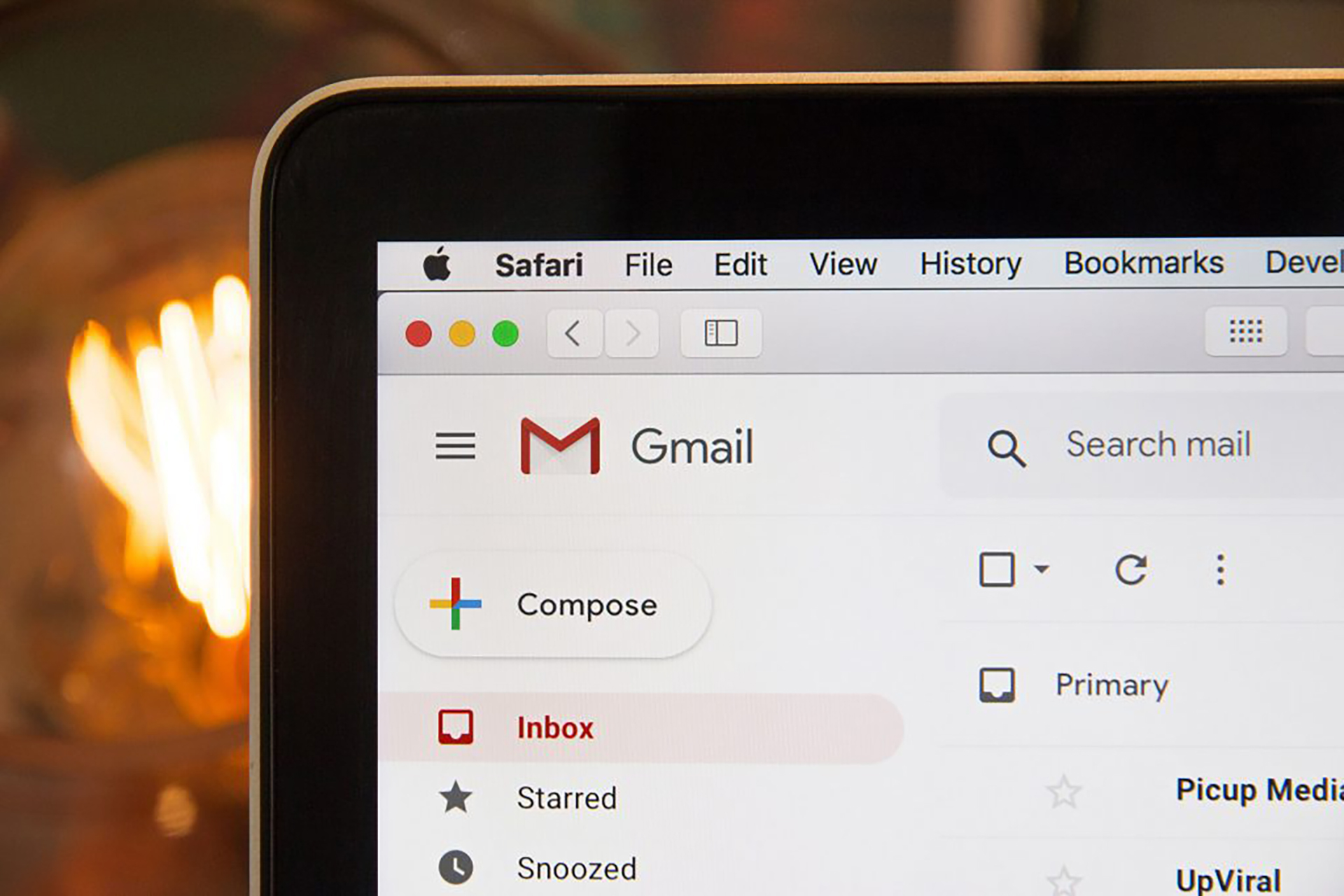

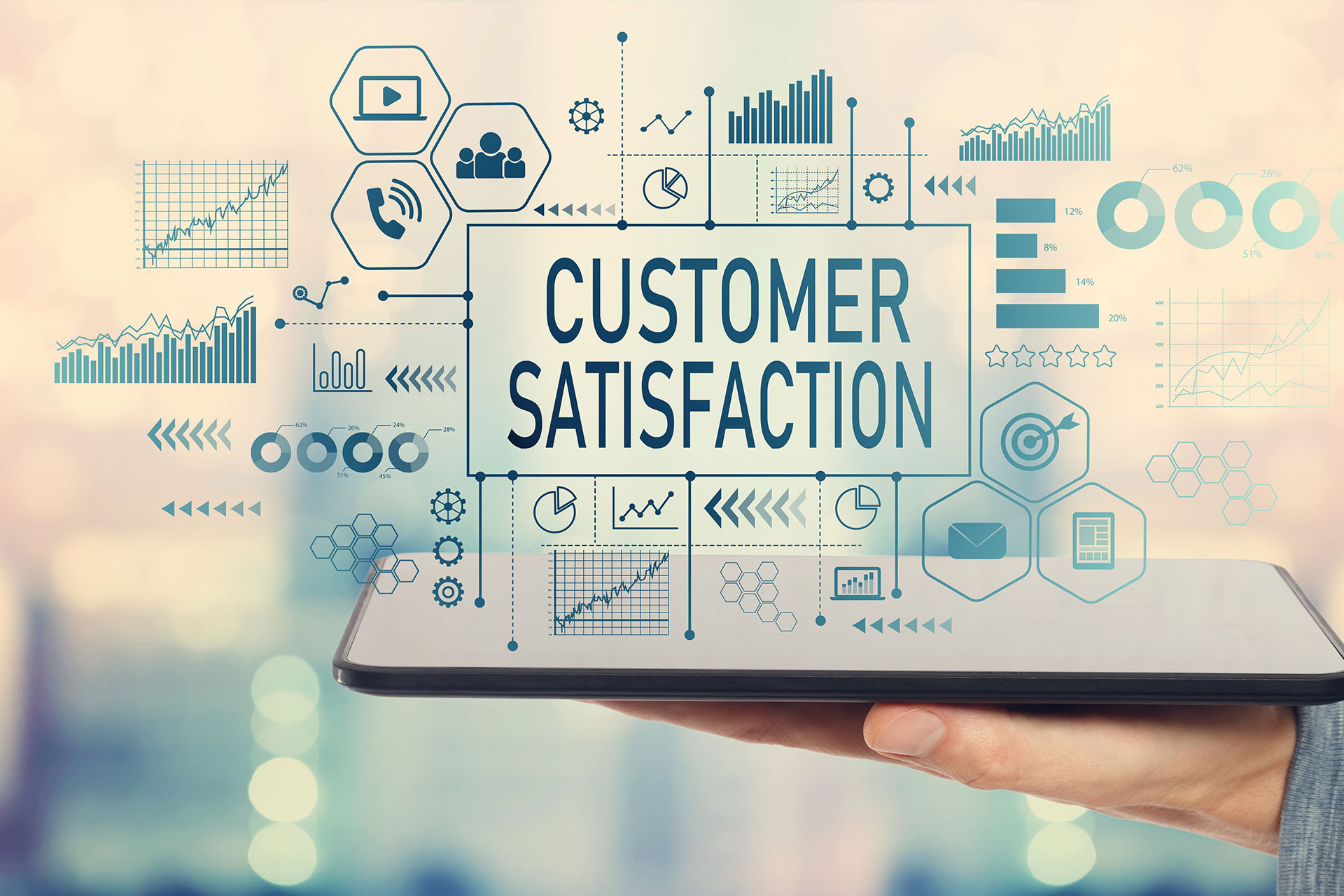

7 Comments
Hi, i think that i saw you visited my web site so i came to “return the favor”.I am attempting to find things to enhance my web site!I suppose its ok to use a few of your ideas!!
Sure! No problem! We’re very glad that our website and the blog posts help you with your website! 🙂
I am really enjoying the theme/design of your site.
Do you ever run into any browser compatibility problems?
A number of my blog visitors have complained about my site not working correctly in Explorer but looks great in Safari.
Do you have any advice to help fix this issue?
Hello Bandar,
What’s your website address? Could we take a look at your website?
Woh I love your articles, saved to bookmarks! .
The examples you provided made it easy to follow along.
Superb and well-thought-out content! If you need some information about Gasoline/Fuel, then have a look here Webemail24